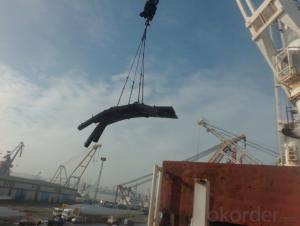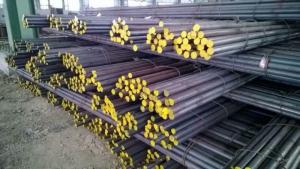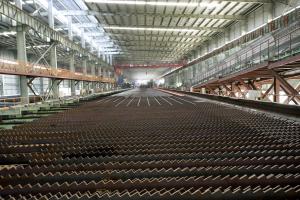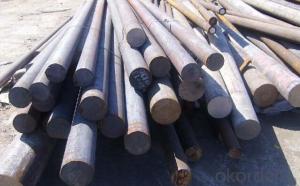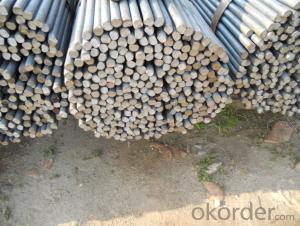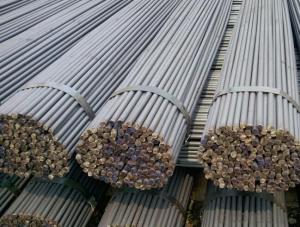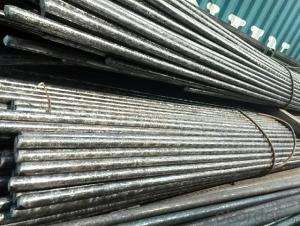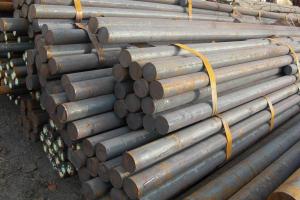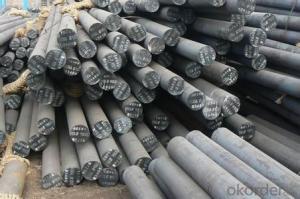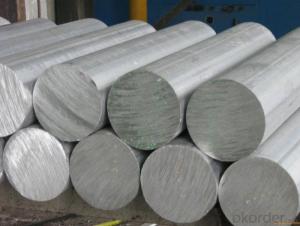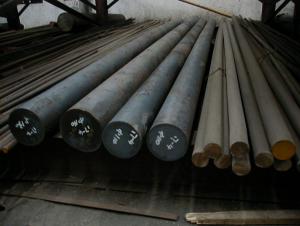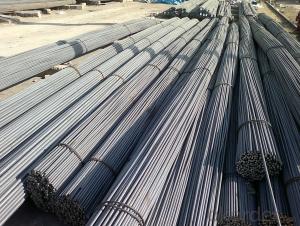Hot Rolled Round Carbon Steel Bar
- Loading Port:
- China Main Port
- Payment Terms:
- TT or LC
- Min Order Qty:
- -
- Supply Capability:
- -
OKorder Service Pledge
OKorder Financial Service
You Might Also Like
Product Description:
OKorder is offering Round Bar at great prices with worldwide shipping. Our supplier is a world-class manufacturer of steel, with our products utilized the world over. OKorder annually supplies products to European, North American and Asian markets. We provide quotations within 24 hours of receiving an inquiry and guarantee competitive prices.
Product Applications:
1. Hot rolled round bar of 6-25mm, or small round is mostly used for straight bundles supply, and used for steel, bolts and various mechanical parts. While the bigger round bar, or more than 25mm hot rolled bar, is mainly for the manufacture of mechanical parts or for seamless steel billet.
2. Besides, we can supply some especial material steel round bar that can be used for main shaft of steamer, hummer shank, with big section and supper force.
Product Advantages:
OKorder's Round Bar are durable, strong, and resist corrosion.
Main Product Features:
· Premium quality
· Prompt delivery & seaworthy packing (30 days after receiving deposit)
· Corrosion resistance
· Can be recycled and reused
· Mill test certification
· Professional Service
· Competitive pricing
Product Specifications:
1. Grade: Q195, Q235, Q345
2. Diameter: 6mm-150mm
3. Length: 6m, 9m, 12m or as customer’s request
4. Tolerance: Within ±5% for weight; ±2mm for diameter
5. Note: The price can be better is the quantity is good
6. Chemical composition
Alloy No | Element (%) | ||||
C | Mn | S | P | Si | |
Q195 | 0.06-0.12 | 0.25 | ≤0.05 | ≤0.045 | ≤0.3 |
Q235 | 0.12—0.20 | 0.3—0.7 | ≤0.045 | ≤0.045 | ≤0.3 |
Q345 | ≤0.2 | 1.00-1.60 | ≤0.045 | ≤0.045 | ≤0.55 |
Payment:
-Invoicing on theoretical weight or actual weight a s customer’s request.
-FOB, CFR or CIF.
-Regular terms of payment:
1, 30% payment in advance, the remaining balance (70% payment) against the copy of B/L.
2, 30% payment in advance, the remaining balance (70% L/C) against the copy of B/L.
3, Negotiable.
FAQ:
Q1: Why buy Materials & Equipment from OKorder.com?
A1: All products offered byOKorder.com are carefully selected from China's most reliable manufacturing enterprises. Through its ISO certifications, OKorder.com adheres to the highest standards and a commitment to supply chain safety and customer satisfaction.
Q2: How do we guarantee the quality of our products?
A2: We have established an advanced quality management system which conducts strict quality tests at every step, from raw materials to the final product. At the same time, we provide extensive follow-up service assurances as required.
Q3: How soon can we receive the product after purchase?
A3: Within three days of placing an order, we will begin production. The specific shipping date is dependent upon international and government factors, but is typically 7 to 10 workdays.
Q4: What makes stainless steel stainless?
A4: Stainless steel must contain at least 10.5 % chromium. It is this element that reacts with the oxygen in the air to form a complex chrome-oxide surface layer that is invisible but strong enough to prevent further oxygen from "staining" (rusting) the surface. Higher levels of chromium and the addition of other alloying elements such as nickel and molybdenum enhance this surface layer and improve the corrosion resistance of the stainless material.
Images:

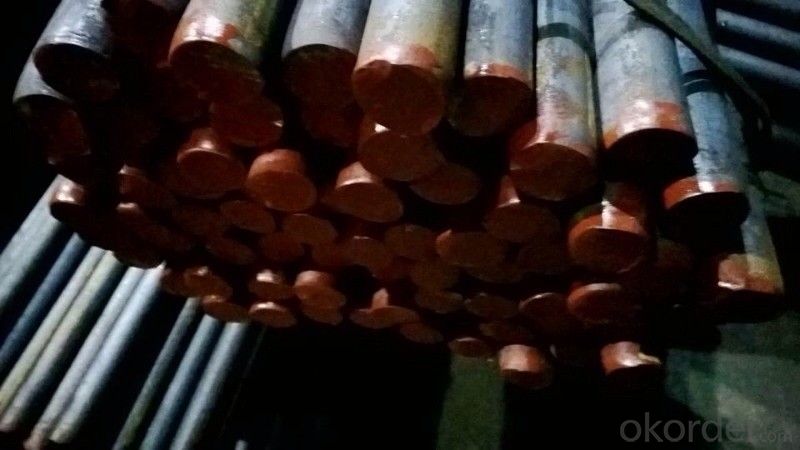
- Q: What are the different types of steel round bar profiles?
- There are several different types of steel round bar profiles, including solid round bars, hollow round bars, and threaded round bars.
- Q: How do steel round bars compare to ceramic round bars?
- The properties and applications of steel round bars and ceramic round bars differ significantly. Steel round bars exhibit exceptional strength and durability due to their composition of iron and carbon alloys, along with additional elements like manganese, chromium, and nickel. They possess high resistance to deformation, can withstand high temperatures, and have impressive tensile strength. As a result, steel round bars find common use in construction, manufacturing, and engineering industries where strength and reliability are vital. Their versatility allows for easy machining and shaping into various forms. On the contrary, ceramic round bars consist of non-metallic materials such as clay, porcelain, or glass. Ceramics offer distinct properties, including heat resistance, corrosion resistance, and wear resistance. Additionally, they are chemically inert and exhibit excellent electrical insulation capabilities. Ceramic round bars are frequently employed in industries that demand high-temperature resistance, chemical resistance, or electrical insulation, such as aerospace or electronic component manufacturing. When comparing steel round bars to ceramic round bars, it is crucial to consider the specific requirements of the application at hand. Steel round bars are preferred for heavy-duty uses where mechanical stress and load-bearing capabilities are essential, owing to their exceptional strength and toughness. Conversely, ceramic round bars are often chosen for their resistance to heat, chemicals, and electrical insulation properties, which play a crucial role in specialized industries. In conclusion, steel round bars and ceramic round bars possess distinct properties and are suitable for diverse applications. Steel round bars excel in heavy-duty uses, owing to their strength and durability, while ceramic round bars are particularly valuable in applications requiring high-temperature resistance, chemical resistance, and electrical insulation.
- Q: What are the common applications of steel round bars?
- Steel round bars have numerous common applications across various industries. One common application is in construction, where steel round bars are used for structural support in buildings, bridges, and other infrastructure projects. They are also commonly used in the automotive industry for manufacturing of components such as axles, crankshafts, and suspension systems. Additionally, steel round bars find applications in the manufacturing of machinery, tools, and equipment due to their strength and durability. They are also utilized in the production of furniture, appliances, and various hardware products.
- Q: What are the different types of steel round bar coatings used in the oil and gas industry?
- Various coatings are commonly utilized in the oil and gas industry to enhance the durability and corrosion resistance of steel round bars. These coatings are essential for protecting the steel from the harsh conditions faced in oil and gas production, transportation, and refining processes. 1. Galvanized Coating: To enhance corrosion resistance, a layer of zinc is applied to the steel round bar through galvanization. This coating effectively safeguards the steel against moisture, chemicals, and exposure to the elements. Galvanized coatings find extensive usage in pipelines, offshore platforms, and storage tanks within the oil and gas industry. 2. Fusion Bonded Epoxy (FBE) Coating: FBE coating involves applying a thermosetting epoxy powder coating to the steel round bar using electrostatic spray. The coating is then fused with heat to form a robust, long-lasting, and corrosion-resistant layer. FBE coatings are widely employed in pipelines, valves, and fittings, providing excellent protection against corrosion, abrasion, and chemicals. 3. Polyethylene (PE) Coating: The application of a polyethylene layer to the steel round bar through extrusion or wrapping methods is known as PE coating. This coating is commonly utilized in oil and gas industry pipelines due to its exceptional resistance to corrosion, chemicals, and impact. Additionally, PE coatings are renowned for their flexibility, enabling the coated bars to withstand ground movement and temperature fluctuations. 4. Polypropylene (PP) Coating: Similar to PE coating, PP coating employs polypropylene instead. PP coatings offer comparable benefits to PE coatings, including corrosion resistance, chemical resistance, and flexibility. They are frequently employed in pipelines within the oil and gas industry, particularly in areas with higher temperatures or where chemical resistance is crucial. 5. Zinc-Nickel Coating: Zinc-nickel coatings involve electroplating a layer of zinc-nickel alloy onto the steel round bar. This coating provides outstanding corrosion protection, even in demanding environments such as offshore installations or high-salinity areas. Zinc-nickel coatings excel in both corrosion and abrasion resistance, making them highly suitable for diverse oil and gas applications. Overall, the utilization of these various steel round bar coatings plays a vital role in preserving the integrity and longevity of equipment and infrastructure in the oil and gas industry. They ensure that the steel bars can endure the challenging conditions encountered during exploration, production, and transportation, thereby reducing maintenance requirements and enhancing safety and reliability.
- Q: Can steel round bars be machined using CNC equipment?
- Yes, steel round bars can be machined using CNC (Computer Numerical Control) equipment. CNC machines are capable of performing a wide range of operations on various materials, including steel round bars. These machines use computer programs to control the movement of the cutting tools, allowing for precise and accurate machining of the steel bars. CNC equipment can perform operations such as turning, milling, drilling, and threading on steel round bars, resulting in the desired shape, dimensions, and surface finish. Furthermore, CNC machines offer high repeatability, consistency, and efficiency, making them an ideal choice for machining steel round bars in industries such as automotive, aerospace, construction, and manufacturing.
- Q: What is the maximum chromium content allowed for steel round bars?
- The allowable chromium content in steel round bars is determined by the grade or specification of the steel. Typically, the chromium content in these bars can span from 0.15% to 30%, although this range may vary depending on the desired properties and intended application of the steel. Stainless steel grades often exhibit higher chromium content as they are renowned for their resistance to corrosion. To ascertain the maximum allowable chromium content for particular steel round bars, it is crucial to refer to the pertinent industry standards or specifications.
- Q: What are the different types of steel round bar alloys for improved toughness and wear resistance?
- Improved toughness and wear resistance are key characteristics in several steel round bar alloys. These alloys are essential in applications where strength and durability are necessary. Some of the commonly utilized alloys are: 1. Alloy Steel: By incorporating elements like chromium, nickel, molybdenum, or vanadium, alloy steel round bars are fabricated to enhance their mechanical properties. These alloys provide increased strength, toughness, and wear resistance. 2. Stainless Steel: With a minimum chromium content of 10.5%, stainless steel round bars are corrosion-resistant alloys. They exhibit excellent toughness, high strength, and superior wear resistance. Industries such as aerospace, automotive, and construction widely rely on stainless steel round bars. 3. Tool Steel: Tool steel round bars are tailor-made for applications that demand high wear resistance and toughness. These alloys are commonly employed in the manufacturing of cutting tools, dies, and molds. By incorporating elements like tungsten, vanadium, or molybdenum, tool steel alloys improve hardness and wear resistance. 4. Carbon Steel: Renowned for their high strength and toughness, carbon steel round bars find extensive use. These alloys contain varying amounts of carbon and are recognized for their excellent wear resistance. Industries including manufacturing, construction, and automotive utilize carbon steel round bars. 5. Bearing Steel: Bearing steel round bars are specifically engineered to withstand high stress and offer excellent wear resistance. These alloys are commonly employed in the production of ball bearings, roller bearings, and other high-performance bearing components. Bearing steel alloys typically include elements like chromium, silicon, and manganese to enhance mechanical properties. To conclude, a range of steel round bar alloys is available, each offering improved toughness and wear resistance. The selection of the most suitable alloy depends on specific application requirements and desired mechanical properties.
- Q: What are the typical price ranges for steel round bars?
- The price of steel round bars can differ depending on multiple factors, such as the steel type, diameter, length, and quantity purchased. Generally, common carbon steel grades can be priced between $1 and $5 per foot. However, specialty and high-grade steel round bars can have higher prices, ranging from $5 to $20 per foot or more. Moreover, larger diameter or longer length steel round bars may also be more expensive due to increased material and manufacturing costs. It is important to note that these price ranges are approximate and can vary depending on market conditions, supplier pricing, and other factors. To obtain an accurate price range, it is advisable to contact steel suppliers or distributors for specific quotes based on your requirements.
- Q: How do you determine the straightness of a steel round bar?
- To determine the straightness of a steel round bar, there are several methods that can be used. One common method is visual inspection, where the bar is carefully examined for any visible bends, twists, or deviations from a straight line. This can be done by placing the bar on a flat surface and checking for any gaps or unevenness between the surface and the bar. Another method is to use a straightedge or a precision ruler. By placing the straightedge or ruler along the length of the bar, any deviations from a straight line can be easily detected. This method allows for more precise measurements and can help identify even slight bends or curves. Measuring devices such as dial indicators or laser alignment tools can also be used to determine the straightness of a steel round bar. These devices provide more accurate measurements and can quantify the degree of straightness by providing numerical readings of any deviations from a straight line. It is important to note that the acceptable level of straightness may vary depending on the specific application or industry standards. In such cases, specific tolerances or guidelines may need to be followed to ensure that the steel round bar meets the required straightness criteria. Overall, determining the straightness of a steel round bar requires careful visual inspection and the use of appropriate measuring tools to ensure that it meets the necessary straightness standards for its intended use.
- Q: Can steel round bars be used for making cooling system components?
- Yes, steel round bars can be used for making cooling system components. Steel is commonly used in the manufacturing of cooling system components due to its high strength, durability, and heat resistance properties. Steel round bars can be machined and shaped into various components such as pipes, fittings, and connectors, which are essential for the smooth operation of a cooling system.
Send your message to us
Hot Rolled Round Carbon Steel Bar
- Loading Port:
- China Main Port
- Payment Terms:
- TT or LC
- Min Order Qty:
- -
- Supply Capability:
- -
OKorder Service Pledge
OKorder Financial Service
Similar products
Hot products
Hot Searches
Related keywords
